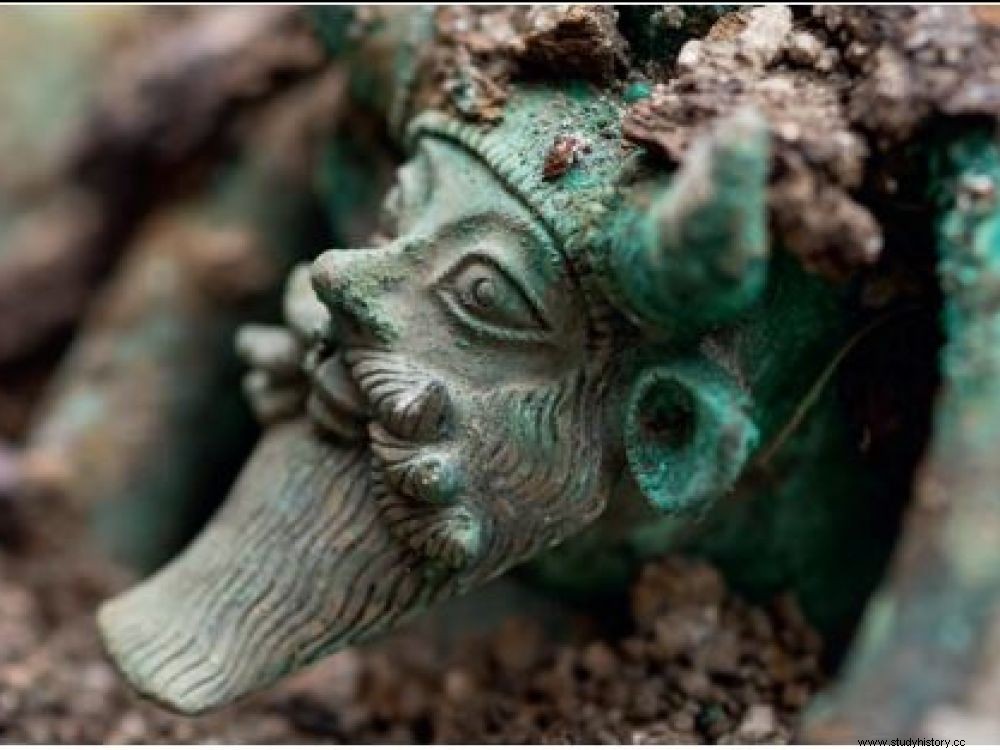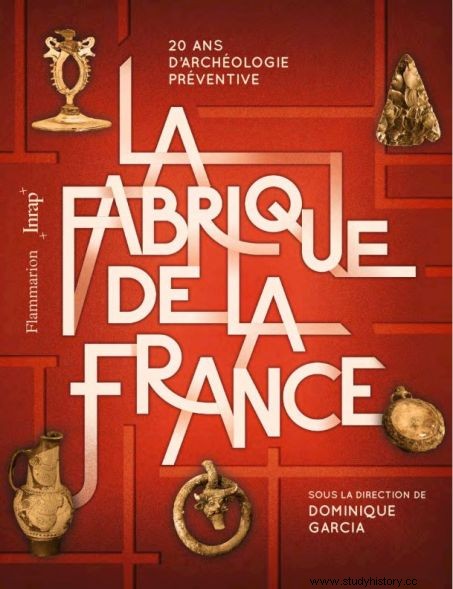President of the National Institute for Preventive Archaeological Research (Inrap), university professor, Dominique Garcia has just edited the book "La Fabrique de la France ". In an interview given to Sciences et Avenir , he returns to this choral book published on the occasion of the next 20 years of the creation of Inrap.

Ornament of one of the four heads of the cauldron of the tomb of the Prince of Lavau (Aube), unearthed in 2014-2015.
"This rigorous and constantly enriched account does not necessarily serve the myth of origins or that of the national novel; it is above all that of our territories in all their states. It does not aim so much to give roots to certain only to offer benchmarks to all, by illustrating the appropriation and evolution of landscapes, the material constitution of identities, permanence and technical innovations, migrations and legacies, the construction of political spaces, conflicts and living together, the local and the forms of globalization, economic, social and cultural changes... everything that has contributed to the "Fabrique de la France". So says Dominique Garcia in the introduction to the eponymous book published by Flammarion (320p., €29) on October 20, 2021. In a media moment when there has never been so much talk of he history, civilization, migration or identity, the contributions of archeology are collective landmarks for the common good. Explanations with Dominique Garcia.
"A book that covers 20 years of activity and the study of 50,000 sites"
Sciences et Avenir:"Far from the national novel drawing the contours of a frozen space, this book unfolds the story of the "Fabrique de la France". Why did you want "go to the roots of our common origins while proposing collective landmarks » ?
Dominique Garcia: After Patrick Boucheron's work on "The World History of France" or those of Christian Grataloup, I found that there was a lack of a publication of this type in archeology. This is why - and for the first time - we have chosen to write a book that covers 20 years of activity and the study of 50,000 sites! The timeline covers the period from Neanderthal to the present day. We present varied discoveries, with a revitalized vocabulary. It is not a manifesto:our objective is to lay down, without sectarianism, in a peaceful and non-militant manner, the terms of contemporary debates. The words cultures, migrations, religion, environment, often used in an overused way, are used here to say that a culture is built; that an identity approaches and evolves. All with concrete examples, which is the great virtue of archaeology.
How has the archeology of the last two decades been able to renew this history?
By addressing, for example, themes as diverse as the presence of Neanderthals in France, the relationship between humans and animals through the issues of animal husbandry, the influence of man on the environment or even the transformation of the environment. By showing that the landscapes which we now fear will disappear have in fact been constantly modified by human presence; that the management of urban space has been a concern since the appearance of the first cities; that the phenomenon of migration has always existed and that it is a natural process. The question of religious practices was also addressed, with the first testimonies on the Christianization of the Roman populations, the Muslim presence in medieval times in the South of France or the archeology of Judaism.

This book, in which some thirty specialists participated, covers a period of one million years. What contributions have particularly changed our knowledge?
The list would be too long to draw up but let us take the example of Neanderthal. Until the work of Inrap, the signs of its presence were occasional. However, thanks to the work of preventive archeology, which leads us to explore very large areas of several hectares, we have found its traces in Normandy, in Hauts-de-France on the banks of the Somme, which has allowed to have a broader understanding of its environment, its ways of life, its cultural productions. The same applies to still little explored themes such as health or the place of disability in past societies.
Inrap's archaeological excavations also take place in the overseas departments. What did you discover?
The interest of preventive archeology is to be able to work on all territories. Inrap is a national institute and we are asked to operate upstream wherever construction sites are launched. Working overseas has allowed us to open up larger research spaces. You have to understand that when you search Reunion, you think about what is happening in Mozambique or South Africa; for the West Indies, our reflection extends to the whole of the Caribbean and to Mesoamerica. Thus, I was a few weeks ago in St Pierre and Miquelon and I was able to see again that working in this region allows me to approach the archeology of North America. Using overseas spaces means having a reflection linked to other regional spaces.
"We are both the heirs of the last world conflict as well as those of Neanderthal"
Preconceived ideas were also challenged...
Absolutely. Concerning Judaism, for example, the excavations that we carried out in several necropolises showed that the mode of burial of the Jews was not different from that of the other members of the society, and that nothing distinguished these burials from the others. The traces of a common life between Jews and Christians in the Middle Ages were obscured by the dramatic expulsions of the 12th and 16th centuries. The same with the three Muslim tombs found in Provence. They have made it possible to reassess the presence of a small medieval community in the regions of Nîmes and Narbonne between 719 and 752, and thus to make up for the deficiencies in written documents.
What has changed in the perception of archeology itself so that excavations now focus on contemporary periods, such as those of the last two world wars?
Our excavations bring elements that are not documented by the texts. We have thus uncovered, among other things, internment camps or hospitals, and we have even been able to highlight unsuspected behavior. Thus, in the East of France, we searched a hospital which received wounded from the 1st World War. And we discovered that these soldiers, away from the horror of the fighting, had taken to gardening and planting trees! By traveling through archeology from Neanderthal to today, we are working on the long term, which is very useful in the current context where we are witnessing endless debates to know if France goes back to Clovis or to another... With our book La Fabrique de la France , we highlight that the identity of France was built in a broader way. We are both the heirs of the last world conflict as much as those of Neanderthal.
You also remember that archeology has now moved from the analysis of sites and objects to the study of genes...
Our excavation sites have effectively become veritable open-air laboratories. The archaeologist is certainly not a Swiss army knife, but he calls on multiple skills to be able to tackle themes as diverse as genomic or geophysical analyses, or the study of Notre-Dame de Paris cathedral after the he fire of 2019, the tombs of the Celtic elites, like that of the Prince of Lavau, of the convent of the Jacobins in Rennes, via Guyana or the Indian Ocean. Inrap archaeologists are at the bedside of a very wide variety of sites. In 2022, the 2200 collaborators of Inrap will celebrate the 20th anniversary of the Institute and it was essential concerning the national space to explain how two decades of preventive archeology and 50,000 excavated sites had made it possible to reveal another story. of the territory.
